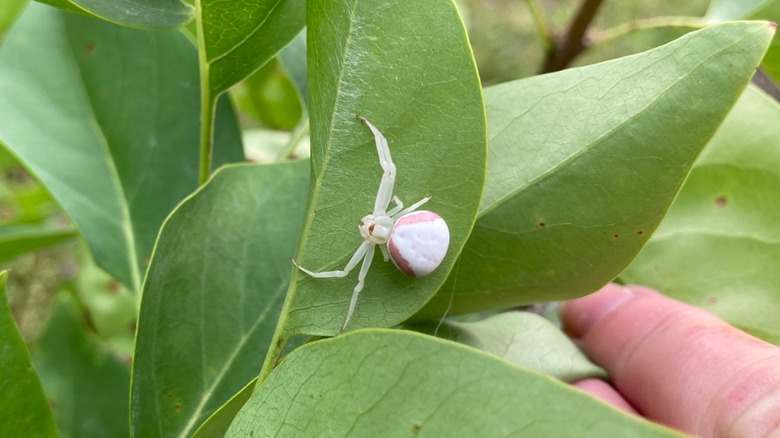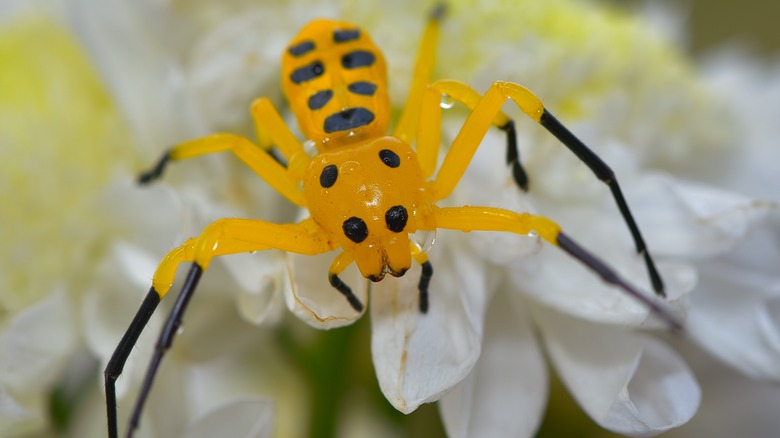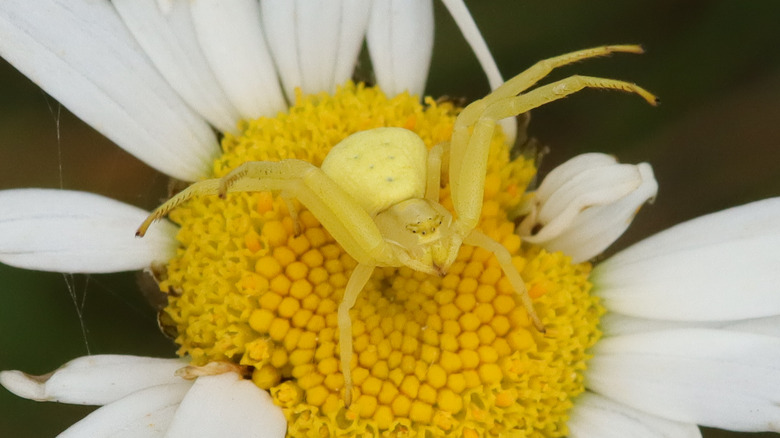Crab Spider: The Beneficial Pest That Won't Leave Webs In Your Garden
While you are looking for ways to minimize your exposure to things like spiders, you may not think about the pests in your garden that are beneficial and helpful. However, some insects — including the crab spider – typically won't come inside your home but will help you keep some problematic pests away from your plants. The crab spider is beneficial to gardens and people alike because it helps to get rid of true pests like moths, mosquitos, and flies that damage plants and cause annoyance.
These spiders are part of the Thomisidae family, with over 200 species in North America. Typically, these spiders are small, about a third of an inch in size. The females tend to have yellow, white, or green coloring and red dots on their bodies, while males are noted for their brown stripes and lighter green belly. Their name comes from their tendency to walk side-to-side, much like a crab does. If the thought of running your hand through a spider web bothers you, that's even more reason to keep crab spiders around. Though these spiders will create silk, they don't typically use it to produce webs, preferring to stalk prey. They use silk to wrap up their eggs to protect them, but you're not likely to have a large area of your garden covered in webbing.
Crab spiders are beneficial to your garden
While crab spiders can be a good addition to keep the garden in a balanced ecosystem, they do feed on some pollinators. They are noted to eat bees, including yellow jackets and honeybees, but their presence has helped these pollinators develop a higher level of skill over generations to detect predators. In this way, crab spiders have helped support bee colonies. As non-discriminatory anthropoid feeders, you'll notice they go after any prey that's available to them.
The work they do to keep destructive pests like months from damaging strawberries or vegetable plants makes them an important tool in a holistic garden environment. Crab spiders work as a natural type of biological control. Without them, it's possible to have too many good pests and pollinators present, which can also lead to the destruction of flowers and other plants. These spiders also feed on pollen and nectar, which helps to contribute to the natural pollination process within your garden. They need this source of sugar and protein to meet their dietary needs when access to a food source is limited.
Promoting a crab spider population in your garden
Unless your area is overrun, there's no need to eliminate spiders from your garden. You may notice them as you work in your garden, such as seemingly being carried away by the small balloons they create using their silk to move from one area to the next, but most of the time, they are hidden and out of the way. They are not known to cause any injury to people, though larger varieties can bite.
To encourage these insects to call your garden home, create the right atmosphere for them. First, avoid using any type of insecticide in the area, especially any type of broad-spectrum insecticide, as this will kill off these helpful pests, too. You also want to create an environment that supports their needs, with areas where they can hide and hunt their prey. They tend to prefer to do so in leaves, mulch, or other organic material, even lurking just below the surface of the soil.
They can also change color to blend in with any flowering plants, which makes them a great choice for blooming flowers that may be overridden by moths or flies. Some crab spider species will change colors over 2 to 21 days to match the foliage, flowers, or even the soil in their environment, enhancing their ability to target prey, and making them a very interesting species to observe in your garden as well.


